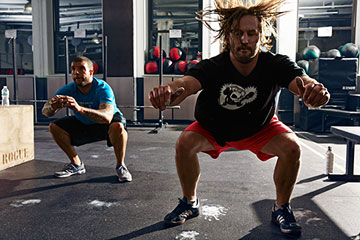
CrossFitters work out in a New York City box. CrossFit preaches constantly varied, high-intensity, functional movement.
(2 of 5)
There is no doubt that CrossFit's high-intensity ethos is exploding. At the end of 2012, there were about 5,000 CrossFit gyms, or boxes, as they are known in CrossFit lingo. A year later, CrossFit had more than 8,000 affiliates worldwide. The company expects to pass 10,000 this year. Revenues were projected to double, to $100 million, over the past year. In 2011, some 26,000 people tried to qualify for the annual CrossFit Games, held in Carson, Calif., which crown the "Fittest on Earth." Last year 138,000 people registered to compete. The games are sponsored by Reebok and broadcast on ESPN. "I am impressed with how CrossFit has fostered a small-tribe mentality," says John Ratey, a professor of psychiatry at Harvard University and the author of Spark: The Revolutionary New Science of Exercise and the Brain. "Anything that creates real human interaction is a big plus for civilization."
CrossFit grew out of one particularly intense tribe when Greg Glassman, a former gymnast who had been training local police in Santa Cruz, Calif., realized that his training methods worked for cops, couch potatoes and Olympic-level athletes alike. The approach is simple: instead of concentrating on cardio on the treadmill or pumping one muscle group, CrossFit mixes pull-ups, burpees, the rowing machine and other activities. You work more muscles, more often and faster. "You have to pick something off the floor--dead lift," says Kyle Smith, a CrossFit trainer in New York City. "You have to put something up on the shelf--shoulder press. These are all movements in our daily lives that we want to do better in the gym."
Glassman, now 57, paired his unyielding approach to exercise with a simple business model. Boxes aren't franchises subject to excessive control from headquarters or state franchise laws. They're independent affiliates: essentially, owners can take a weekend Level 1 certification course for $1,000, pass a test and then apply to open a CrossFit box. If CrossFit signs off, the annual fee is now $3,000. The local gyms keep all revenue; in general, CrossFit membership goes for $125 to $200 a month. "You're in charge," Glassman said in a 2012 interview posted on CrossFit.com "Remove everything between you and your success that isn't essential. I mean, that's a beautiful thing."
When done correctly, CrossFit training works. In a November study published in the Journal of Strength and Conditioning Research, exercise scientists from Ohio State University measured the body-fat percentage and aerobic endurance of 43 subjects before and after they completed an intensive, 10-week CrossFit program. The results: body fat significantly decreased and endurance significantly increased for both men and women across all levels of prior workout experience and body composition.
Catherine Yeager, 42, a psychologist from Grand Forks, has lost 30 lb. since starting CrossFit in June 2012. "Before that, I'd run the treadmill and do some random weight lifting, and I started to feel like I wanted to cry, it was so boring," says Yeager, who has no real athletic background. She used to concoct reasons to sit out PE. Now she can do handstand push-ups.
